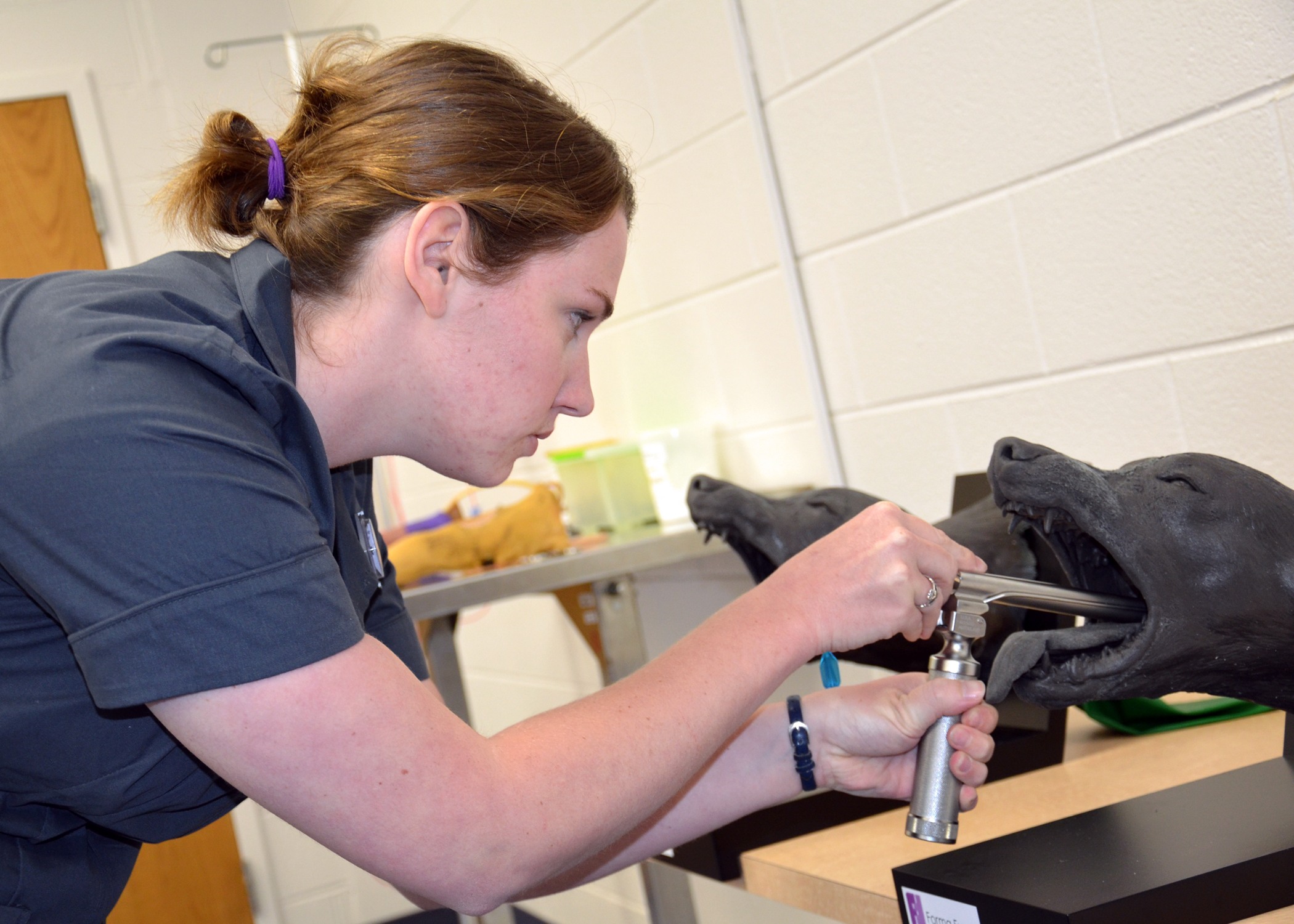New lab offers veterinary students a place to practice their clinical skills

Students at the Virginia-Maryland College of Veterinary Medicine at Virginia Tech now have access to a new teaching and learning space where they can perfect their clinical skills before performing them on live animals.
Even though it only opened last spring, the clinical skills lab has already given veterinary students valuable, hand-on experiences.
Stocked with models and mannequins that resemble live animals, the lab allows first-, second-, and third-year veterinary students to practice clinical skills such as bandaging, catheterization, intubation, and suturing before they begin their fourth-year clinical rotations.
Anna Katogiritis of Karpathos, Greece, a second-year veterinary student, explained that practicing on models made her feel more confident about clinical techniques that she had not fully grasped in the past.
“The models have vein-like tubes in their legs that really allow you to perform techniques as if you were practicing on a real animal,” she said. “At the same time, knowing that I was not putting a live animal at risk or distress eliminates the stress factor and allowed me to focus on the techniques themselves.”
The clinical skills lab is open 24 hours a day, seven days a week, and has veterinarians and veterinary technicians available to assist students during certain hours. Dr. Meghan Byrnes, a multi-discipline laboratory instructor, set up the new space.
“When the lab is staffed, students can receive instruction and immediate feedback on their skills,” Byrnes said. “In addition, the lab is always open for use, even when it is not staffed, so students have the option to use it at their convenience. Each station has written directions and task sheets that explain the steps to each procedure.”
Jason Regalado of Sacramento, California, a third-year veterinary student, agrees that the clinical skills lab has helped supplement his classroom instruction.
“It being open 24/7 is a boon as a late-night ‘study break’ from book and computer learning,” he said.
Regalado has used the new lab to try out several clinical techniques. He has used one station with models of dogs’ heads to practice intubation, identifying the parts of the anesthesia machine, and checking for leaks in the system. He has also used the lab to better understand electrocardiogram lead placement, gowning and gloving, instrument handling, and even toxic plant identification. A suturing table allows Regalado and other students to practice stitching on foam, as well as materials that mimic the texture and thickness of animal skin.
Although the lab was designed with students in their first three years of training in mind, Byrnes explained that fourth-year veterinary students have also utilized the space. In their fourth-year, veterinary students spend 12 months completing three-week blocks that expose them to various aspects of veterinary medicine at the Veterinary Teaching Hospital and elsewhere. Faculty members and student clubs can also reserve the clinical skills lab for classes and workshops.
“Through repetition and immediate feedback from instructors, students can successfully integrate knowledge and skills learned in veterinary school,” said Byrnes, who explained that clinical skills labs like the one at the Virginia-Maryland College of Veterinary Medicine are becoming more common at veterinary schools.
Katogiritis has seen first-hand the value of these spaces for veterinary instruction. During a trip to the University of Edinburgh in Scotland, she visited a newly opened clinical skills lab for that university’s veterinary program.
“Labs like these are extremely helpful and useful for students,” Katogiritis said. “I know that not all the students that enter veterinary schools have an extended animal experience. Some have indeed worked for years as veterinary technicians, but others had either focused on research or other areas. Therefore, allowing all students to practice, without putting actual patients in danger, is invaluable in my opinion. I think that the current lab has a lot of potential.”
Written by Michael Sutphin.





